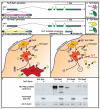Rabs on the fly: Functions of Rab GTPases during development
- PMID: 28118081
- PMCID: PMC6380344
- DOI: 10.1080/21541248.2017.1279725
Rabs on the fly: Functions of Rab GTPases during development
Abstract
The organization of intracellular transport processes is adapted specifically to different cell types, developmental stages, and physiologic requirements. Some protein traffic routes are universal to all cells and constitutively active, while other routes are cell-type specific, transient, and induced under particular conditions only. Small GTPases of the Rab (Ras related in brain) subfamily are conserved across eukaryotes and regulate most intracellular transit pathways. The complete sets of Rab proteins have been identified in model organisms, and molecular principles underlying Rab functions have been uncovered. Rabs provide intracellular landmarks that define intracellular transport sequences. Nevertheless, it remains a challenge to systematically map the subcellular distribution of all Rabs and their functional interrelations. This task requires novel tools to precisely describe and manipulate the Rab machinery in vivo. Here we discuss recent findings about Rab roles during development and we consider novel approaches to investigate Rab functions in vivo.
Keywords: Rab GTPases; Staccato/Munc13-4; cell polarity; lysosome related organelles (LROs).
Figures




Similar articles
-
Toward a comprehensive map of the effectors of rab GTPases.Dev Cell. 2014 Nov 10;31(3):358-373. doi: 10.1016/j.devcel.2014.10.007. Epub 2014 Nov 10. Dev Cell. 2014. PMID: 25453831 Free PMC article.
-
How can mammalian Rab small GTPases be comprehensively analyzed?: Development of new tools to comprehensively analyze mammalian Rabs in membrane traffic.Histol Histopathol. 2010 Nov;25(11):1473-80. doi: 10.14670/HH-25.1473. Histol Histopathol. 2010. PMID: 20865669 Review.
-
Endogenously tagged rab proteins: a resource to study membrane trafficking in Drosophila.Dev Cell. 2015 May 4;33(3):351-65. doi: 10.1016/j.devcel.2015.03.022. Dev Cell. 2015. PMID: 25942626 Free PMC article.
-
Comprehensive analysis reveals dynamic and evolutionary plasticity of Rab GTPases and membrane traffic in Tetrahymena thermophila.PLoS Genet. 2010 Oct 14;6(10):e1001155. doi: 10.1371/journal.pgen.1001155. PLoS Genet. 2010. PMID: 20976245 Free PMC article.
-
Rab GTPases and cell division.Small GTPases. 2018 Mar 4;9(1-2):107-115. doi: 10.1080/21541248.2017.1313182. Epub 2017 May 4. Small GTPases. 2018. PMID: 28471300 Free PMC article. Review.
Cited by
-
Rab-mediated trafficking in the secondary cells of Drosophila male accessory glands and its role in fecundity.Traffic. 2019 Feb;20(2):137-151. doi: 10.1111/tra.12622. Epub 2018 Dec 26. Traffic. 2019. PMID: 30426623 Free PMC article.
-
LncRNA EBLN3P promotes the progression of osteosarcoma through modifying the miR-224-5p/Rab10 signaling axis.Sci Rep. 2021 Jan 21;11(1):1992. doi: 10.1038/s41598-021-81641-6. Sci Rep. 2021. PMID: 33479458 Free PMC article.
-
Understanding the interplay of membrane trafficking, cell surface mechanics, and stem cell differentiation.Semin Cell Dev Biol. 2023 Jan 15;133:123-134. doi: 10.1016/j.semcdb.2022.05.010. Epub 2022 May 28. Semin Cell Dev Biol. 2023. PMID: 35641408 Free PMC article. Review.
-
The Succinate Receptor SUCNR1 Resides at the Endoplasmic Reticulum and Relocates to the Plasma Membrane in Hypoxic Conditions.Cells. 2022 Jul 13;11(14):2185. doi: 10.3390/cells11142185. Cells. 2022. PMID: 35883628 Free PMC article.
References
-
- Bourne HR, Sanders DA, McCormick F. The GTPase superfamily: a conserved switch for diverse cell functions. Nature 1990; 348:125-132; PMID:2122258; http://dx.doi.org/10.1038/348125a0 - DOI - PubMed
-
- Zeigerer A, Bogorad RL, Sharma K, Gilleron J, Seifert S, Sales S, Berndt N, Bulik S, Marsico G, D'Souza RC, et al.. Regulation of liver metabolism by the endosomal GTPase Rab5. Cell Reports 2015; 11:884-892; PMID:25937276; http://dx.doi.org/10.1016/j.celrep.2015.04.018 - DOI - PubMed
-
- Aderem A, Underhill DM. Mechanisms of phagocytosis in macrophages. Annual Rev Immunol 1999; 17:593-623; PMID:10358769; http://dx.doi.org/10.1146/annurev.immunol.17.1.593 - DOI - PubMed
-
- Beningo KA, Wang YL. Fc-receptor-mediated phagocytosis is regulated by mechanical properties of the target. J Cell Sci 2002; 115:849-856; PMID:11865040 - PubMed
-
- Jaconi ME, Lew DP, Carpentier JL, Magnusson KE, Sjogren M, Stendahl O. Cytosolic free calcium elevation mediates the phagosome-lysosome fusion during phagocytosis in human neutrophils. J Cell Biol 1990; 110:1555-1564; PMID:2110568; http://dx.doi.org/10.1083/jcb.110.5.1555 - DOI - PMC - PubMed
Publication types
MeSH terms
Substances
LinkOut - more resources
Full Text Sources
Other Literature Sources
Molecular Biology Databases
